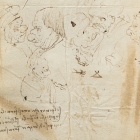Leonardo da Vinci’s Notebook (Cod. Triv. 2162) is a small paper manuscript in which - within a few years (from about 1487) - Leonardo drew physiognomic sketches, architectural drafts for the Duomo and other Milanese buildings, and also mechanical sketches and designs for war machines. On seven of the pages there are drawings made using a metal stylus that are clearly visible when the pages are illuminated at a low angle. In some cases these sketches were subsequently drawn over with ink. The manuscript is distinctive for its long lists of words written in Leonardo’s characteristic cursive script from right to left. The lists record the artist’s attempt to enrich his vocabulary with words of Latin origin, so as to make his scientific writings appear more authoritative and so as to be able to better grasp the writings of other humanists and men of science. After the death of the artist, the Notebook was left to his pupil Francesco Melzi. Together with other Leonardo’s manuscripts, the Notebook came into the possession of Pompeo Leoni. In 1632 it was acquired by Galeazzo Arconati, who then donated it to the Biblioteca Ambrosiana in 1637, taking it back at a later date in exchange for another of Leonardo’s manuscripts. All traces of the codex were lost, until it reappeared in the mid-1700s as part of the Trivulzio collection, which was incorporated into the Castle’s Archivio Storico Civico e Biblioteca Trivulziana in 1935.
Leaf through the manuscript








